
Whatever Floats Your Bike

Blog 40 by Mick: Whatever Floats Your Bike
Back in Arusha we had a few little jobs to do before hitting the road, and I’m not just talking of the ever present bike maintenance. We had to decide where to go. We had about 2 weeks available to us to get to Nairobi where Tanya had booked her next exam for her BComm, but the problem was it was only 270km away. Looking at the map we figured we could get to Nairobi taking the scenic route around Lake Victoria through Rwanda and Uganda. It was 10 times the direct distance at 2700km, but what the hell; looking around was what we are here for.
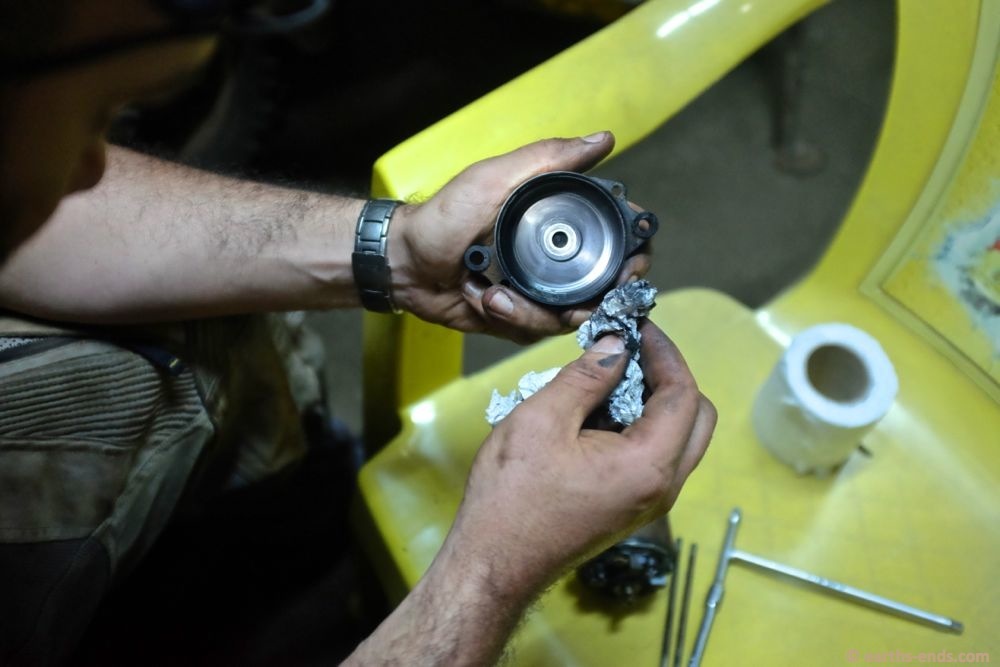
Tanya’s starter motor had been binding up for some time with carbon from the brushes and it needed a bit of a clean out. I also noticed that the bearing in the Warp 9 end cap was quite notchy so popped the seal off and greased it. I’d definitely recommend anyone who gets one of these new to do this, it was very dry in there and spun much better with some grease.
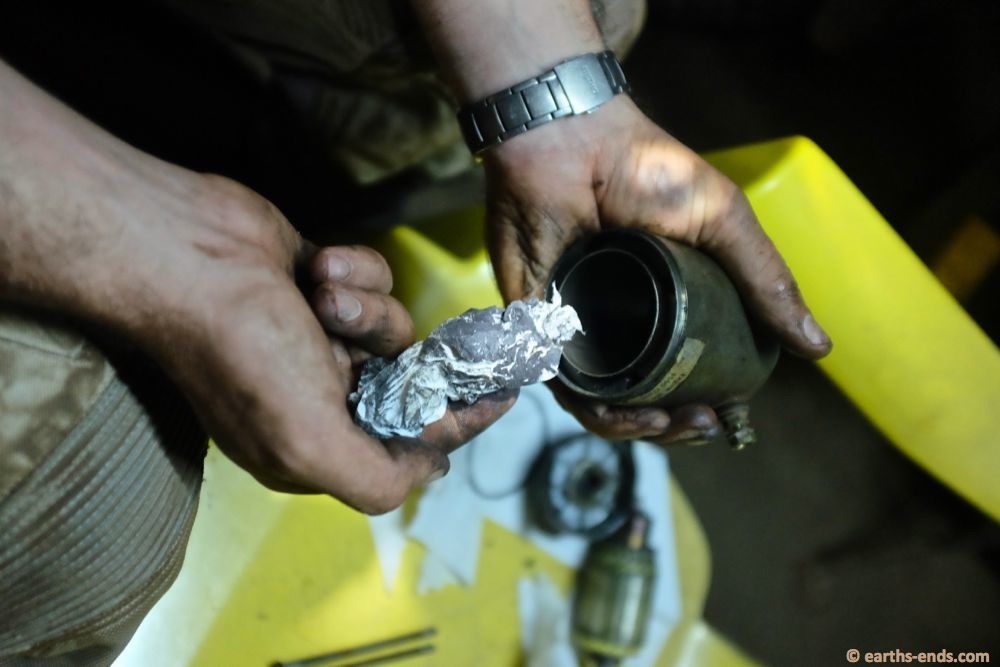
Carbon binding up the commutator

Cleaning the starter and re-seating the brushes before reassembly. We’ve put 15000kms on the bike since this quick bit of maintenance and its started perfectly ever since.
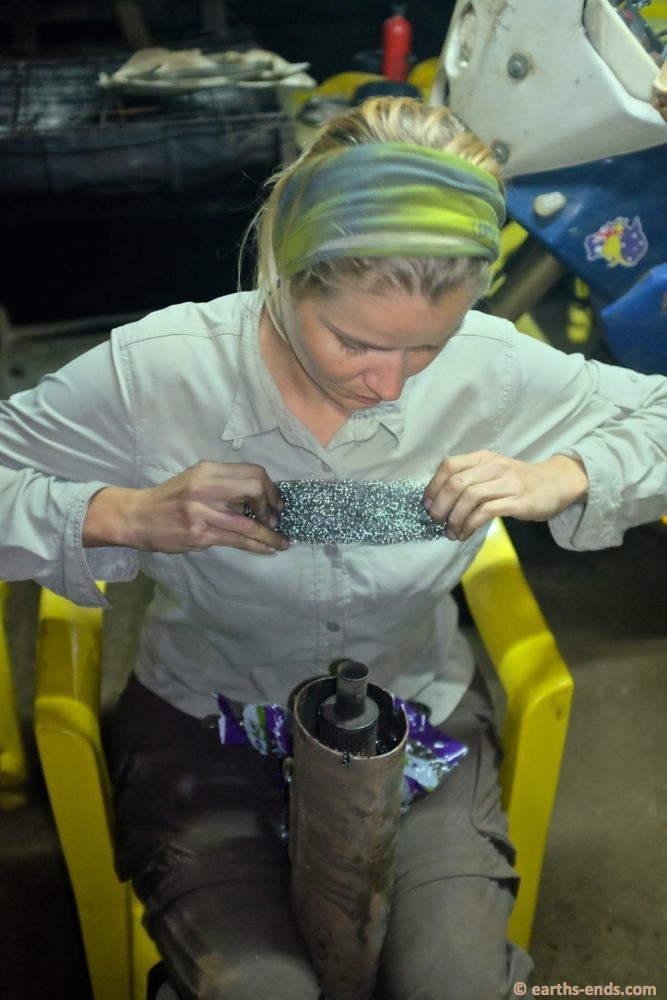
While we were at it, Tan repacked the exhausts. The last time we did this was about 23000kms ago in Stellenbosch, South Africa.
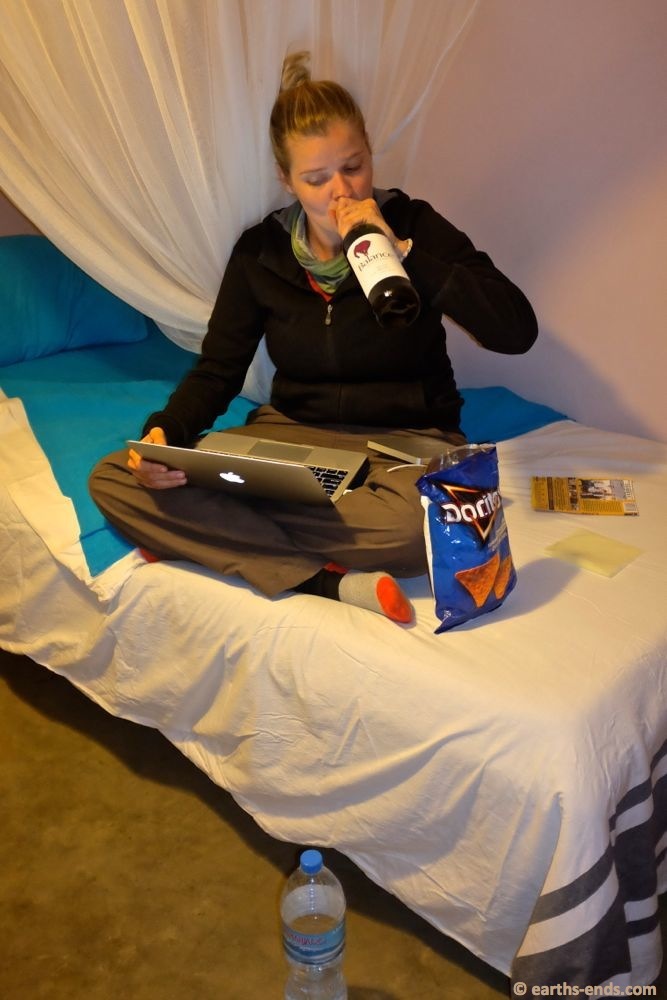
Movie night with wine and nibblies…. Busted arse RTW biker style

Some handy parking for brunch at a local restaurant
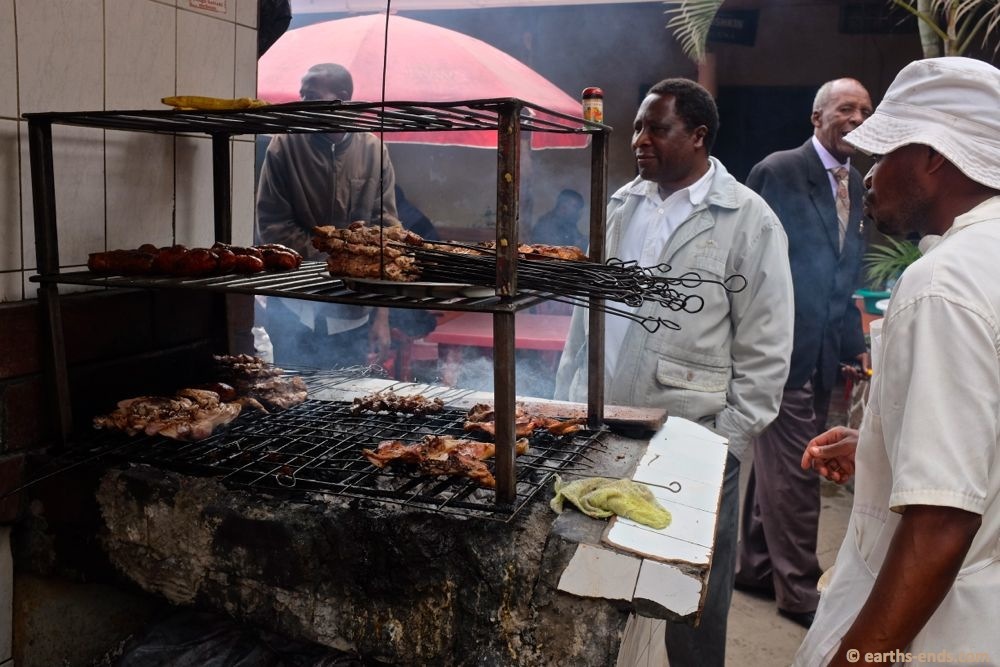
The ubiquitous bbq. Every little restaurant in this part of the world has one of these with some goat or chicken roasting away. This place did home made sausage which was really pretty good. We wisely never asked what was in it!
First stop wasn’t far away, just 160km west in the town of Karatu where we had been invited to drop in on a fellow advrider inmate. William worked at an American run private hospital providing first world medical care to the community at heavily subsidised rates. And it was a real impressive little show. Construction only started in 2008 and in the seven years since they have grown to the point they can provide all sorts of specialised services.
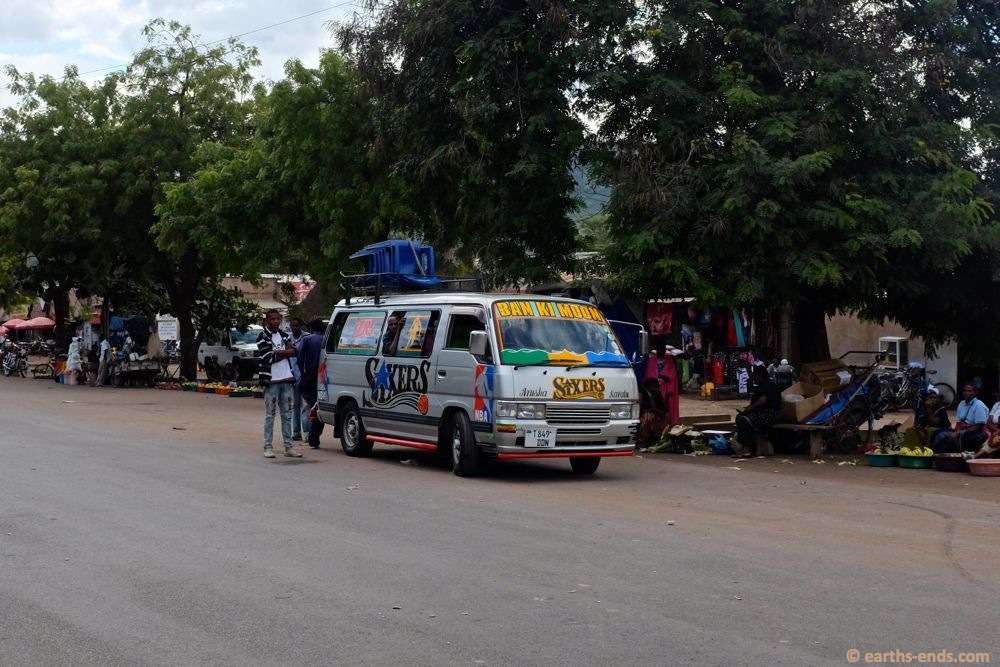
Every matatu/communal taxi has some sort of silly stickers on it. This one was unique though, the driver was obviously a fan of the South Korean UN Secretary General Ban Ki Moon.
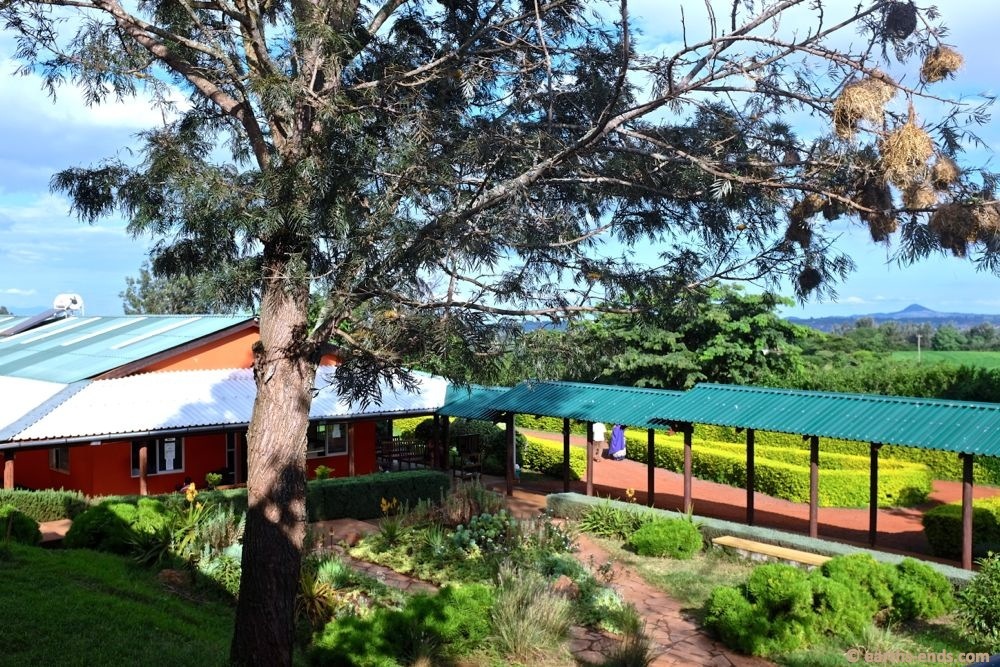
The grounds of the FAME (Foundation for African Medicane and Education) hospital (www.fameafrica.org). If you get sick or need medical attention in or around Karatu, I recommend you go here. It was an impressive little hospital.
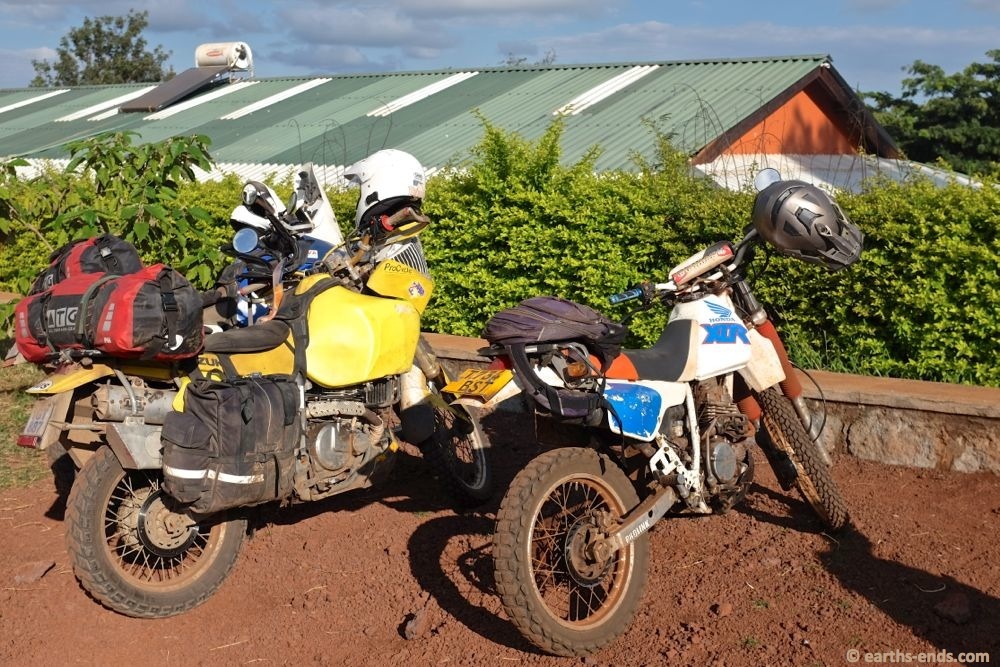
William’s little XR250 next to our big behemoths
William offered us his spare room for the night which we gratefully accepted as the sun was starting to get a bit low on the horizon. Over dinner we got talking about our route west to Rwanda and William mentioned there were 3 ways we could go; the tar, which we were avoiding where possible due to the insane buses; a main dirt road, which was shorter and what I had planned on taking; or a very interesting little route where at one stage there was no roads and we would be forced to cross a river in a canoe.

Discussing routes with William. Tan was like “act natural!”… err what?
Yep, you are probably right now just like I was when I heard that 3rd option. “Peaked my interest” is an understatement…. Put the bikes in a canoe…. That sounds rather interesting indeed. When William mentioned that we would be riding alongside Lake Eyasi which is the territory of the very rare Hadza hunter gather tribe or the Datoga pastoralist tribe, it was too much. “William! You had me at ‘canoe’! You had me at ‘canoe’!!!”
I hate Tom Cruise movies by the way, but the Jerry Maguire reference seemed fitting.
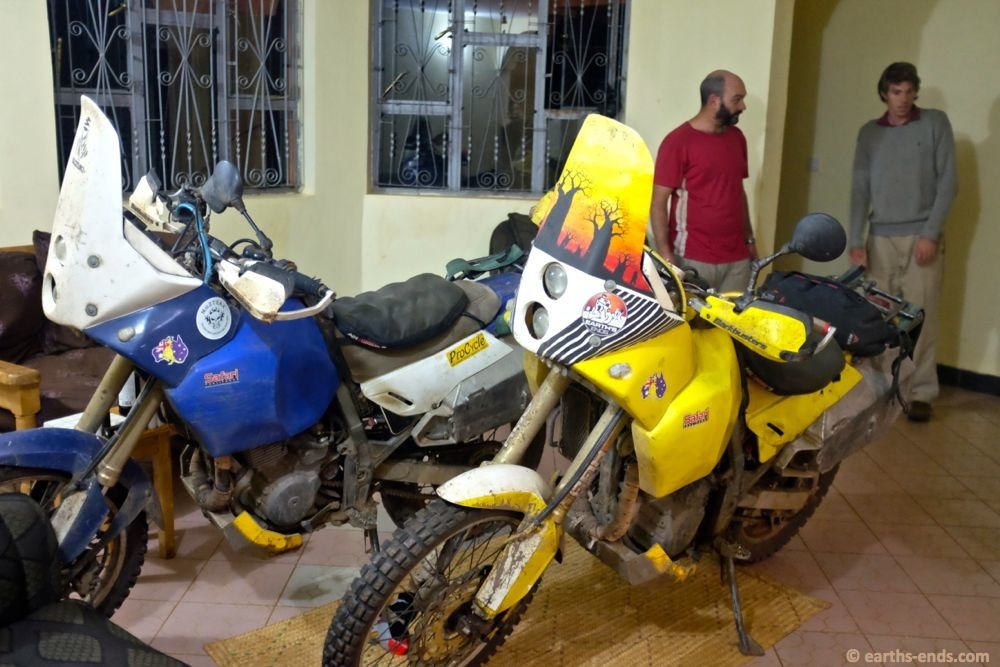
We parked our bikes in William’s living room for the night.
So we got away relatively (for us) early the next morning, about 9am. William had provided us with a list of village names to ask for as we made our way south, the co-ords of the canoe crossing, and the approximate location of a “tourist gate” we had to get through before they closed it for the morning. Turns out that a number of years ago the Tanzanian Government suggested that local tribal groups could charge tourists a fee to visit tourist attractions on tribal land. Sounds fair right? Yeah I think so too, but…. well, the trouble is those groups have interpreted the law to mean they can put gates over public roads and charge non-Africans (doesn’t matter if you’re a resident) a fee to use the road. Doesn’t matter if you’re using the road to access attractions (like a tourist) or just as a thoroughfare to get somewhere else (like us), you pay if you are not African. So basically it is a racial toll-gate, and an expensive one at that. Most are USD15 per (white) person!
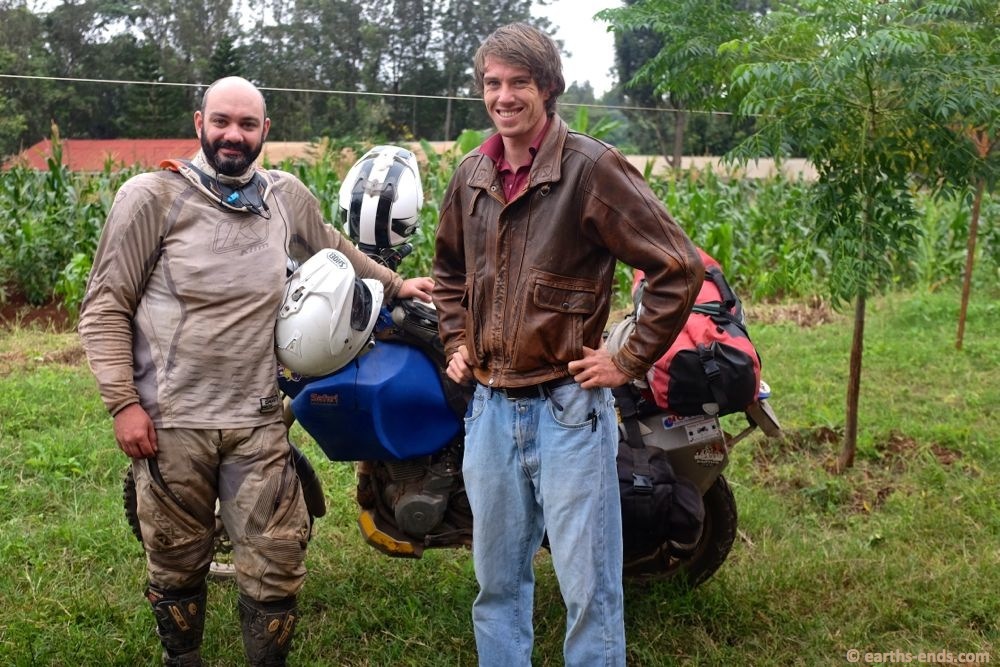
Saying good bye the next morning. Thanks for the invite William!
We would be going through one such gate on our way south and William suggested that that we should get through it before 10am, about when it closes. Apparently during ‘peak-hour’ when there is lots of local traffic, the gates are annoying so they are left open, but they are closed mid-morning when the traffic slows and the tourists (might) start turning up. So we timed our arrival for a bit before 10, and made sure we rode through side by side so there would be no first rider to alert the gate attendants and a second rider to cop the fee. Plan was for us to both slip through before they realised.

Just past the tourist gate we stopped to grab a snack and a photo
And so it turned out. We saw the gate house but zipped through and off into the figurative sunset before anyone spotted us. I’m not even sure if the gate house was actually manned at the time to be honest. We saw no one. Anyway, we immediately turned south and off the last of the marked routes on my Tracks4Africa GPS maps to head around the bottom side of Lake Eyasi. We were now navigating on a dead reckoning to the canoe crossing co-ords and following a list a village names. If we were lucky we would meet a few Hadza or Datogo people along the way. It had the makings of a bloody good day.

About 15km past the tourist gate the road quickly deteriorated… Lots of erosion damage and some sand to spice things up.

PHOTO STOLEN FROM THE NET. The Datoga who live in the area are known for their women who wear elaborate flat and wide copper looking necklaces. We saw two women like this; one quite close while we stopped for a warm coke in Bukundi. Once again, she was quite reserved and we missed our photo opportunity. But we were lucky to witness them none the less. We were also hoping to meet some people from the hunter gatherer Hadza tribe that lives along the lake side. We did get to see what we think were some of these people from a distance but they were very shy and reserved and difficult to approach. They wore shorts with knee and sometimes elbow jewelry. I’ve struggled to find a decent photo online of what we saw so a description will have to do!
It wasn’t far until the road deteriorated. Significantly. Many moons ago some adventurous civil construction types had come out here and built what probably was a pretty decent dirt road. Just one small problem. Drainage. It would seem that drainage wasn’t really considered, at all, and now the road was cut every 300 metres or so with erosion ditches were seasonal streams coming from the mountains had cut through the road foundations as they drained into Lake Eyasi. At some points the road was gone completely and what was left was unridable, forcing us to bush bash around the eroded mess and meet up again with what road the flowing water had generously left behind. There was about 70-80km of this stop start riding which took us over 2 hours to complete.

Some of the erosion damage to the road. Some of it was fine, some of it was a headache
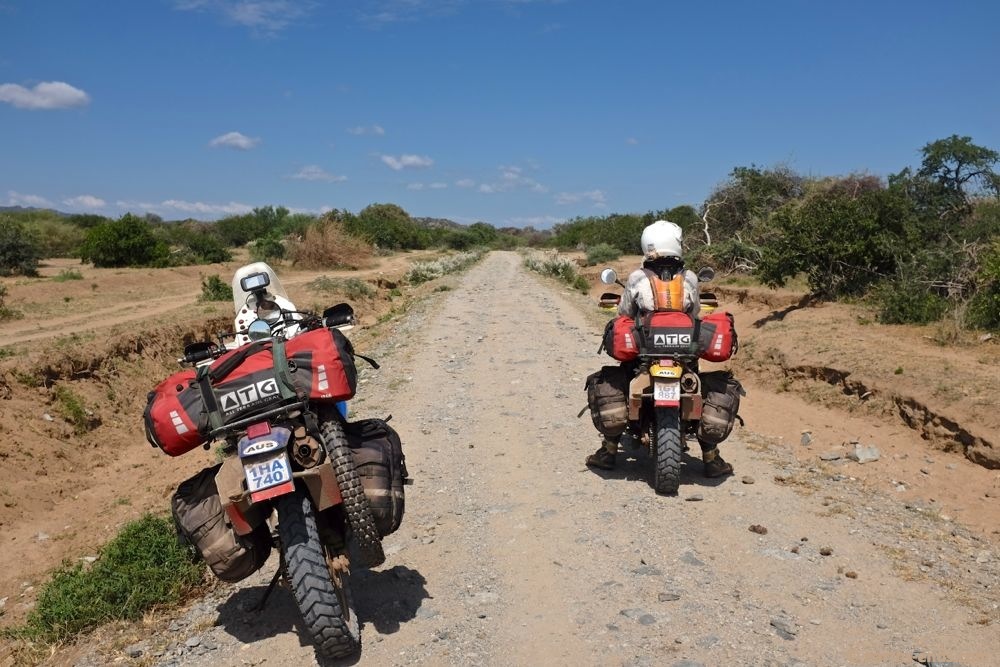
Heading south on a good section of old road. We would get 300m of this, then slow down for an erosion gully. Then repeat. For 70km.
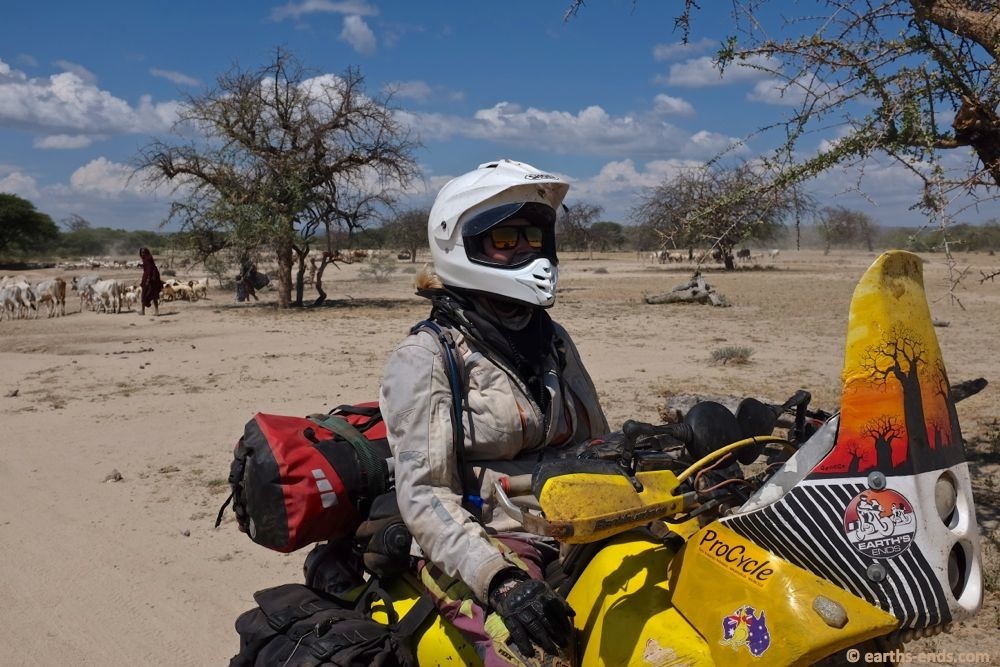
A quick break with some Datoga pastoralists in the background
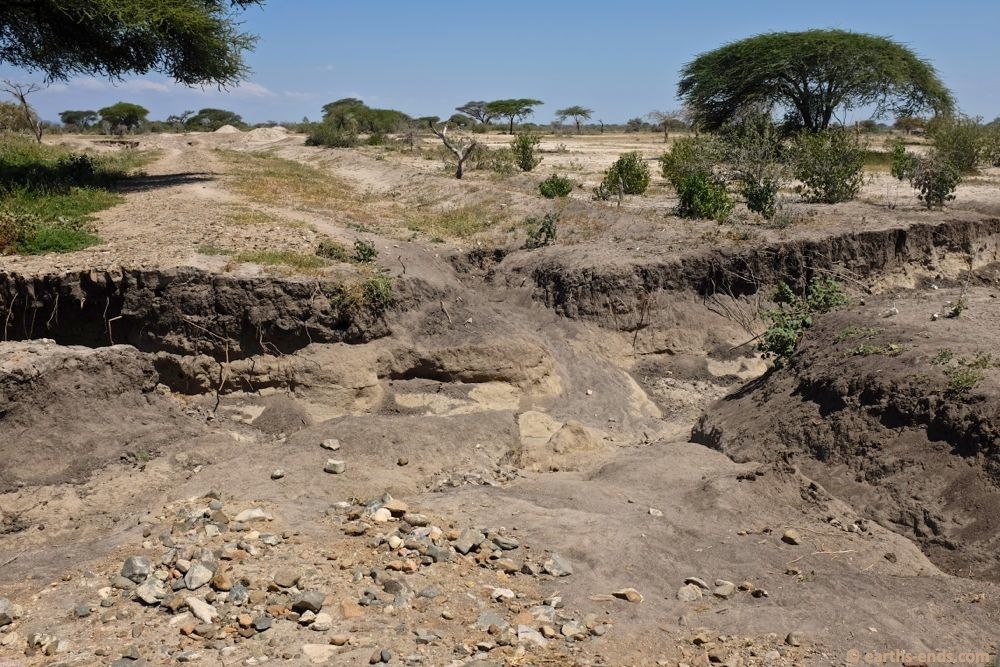
One of the more significant erosion gullies. There were a handful about this bad.
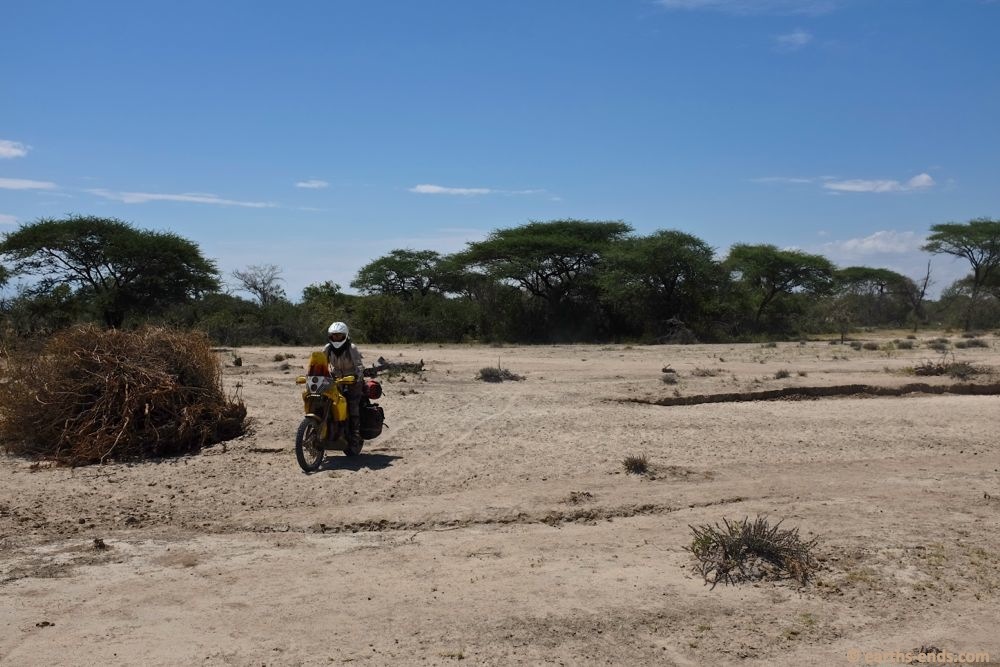
We bush-bashed around this one, thankfully avoiding flats

Yet more significant flooding damage. You’d struggle to get a car down this road.
We reached the last village that William had given us a name for on the eastern side of the river. Following the bearing on the gps towards the river crossing, the road disappeared and we were on nothing but piki-piki trails; Piki-piki being the Swahili word for motorcycle and used in these parts in reference to cheap, small capacity (between 80-150cc) Indian and Chinese bikes. They are everywhere in Africa, even in the remotest little village far from a service station.
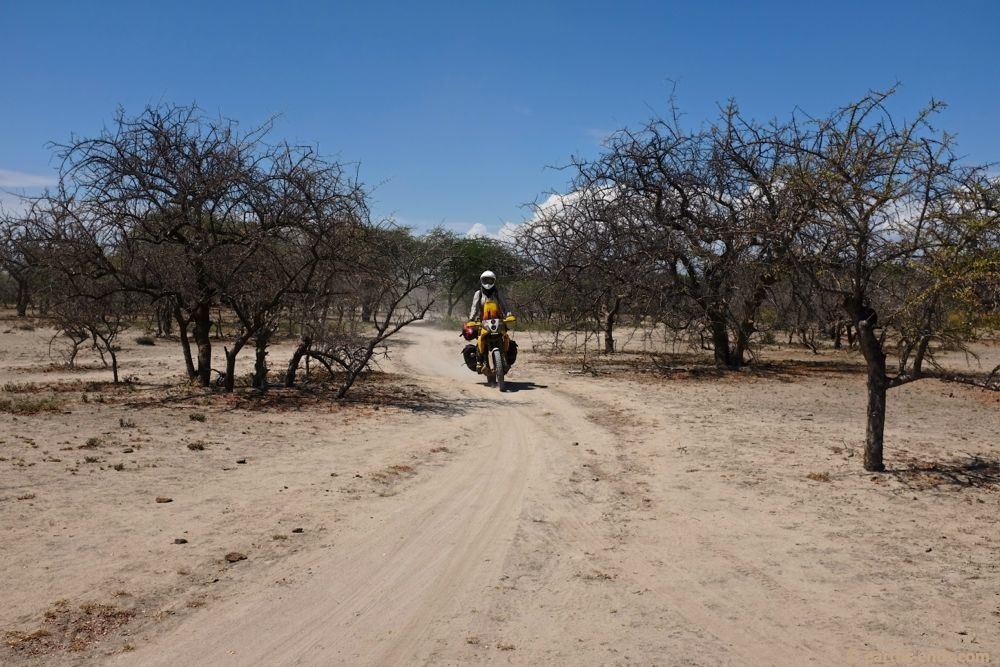
Tan on the piki-piki trails…. Its obvious I had the camera this day, every photo is of Tan…
One issue with them being everywhere is finding the right trail to get to the river crossing. We followed our noses and ended up on a trail heading too far south, so back tracked and found another trail on a more westerly bearing and got on that instead. We picked a winner and after some smooth single track through acacia thicket, we arrived at the river and were greeted with some amused and perplexed looks from the ferrymen.

Riding through the acacia. No roads out here.
While discussing the route with Wiliam, I had quizzed him as to the river’s width/depth/current conditions to ascertain whether it might be possible to ford the river. But now I could see why he wasn’t confident, and why the canoe ferries existed. While the river was not wide, maybe only 20m, it was deep. And worse still, the soil in the region was a very fine loamy clay meaning that the river bed was endlessly deep sticky mud. Even if the river was 20cm deep you wouldn’t get across without a winch to drag you through. It would have to be basically bone dry to ever ford.
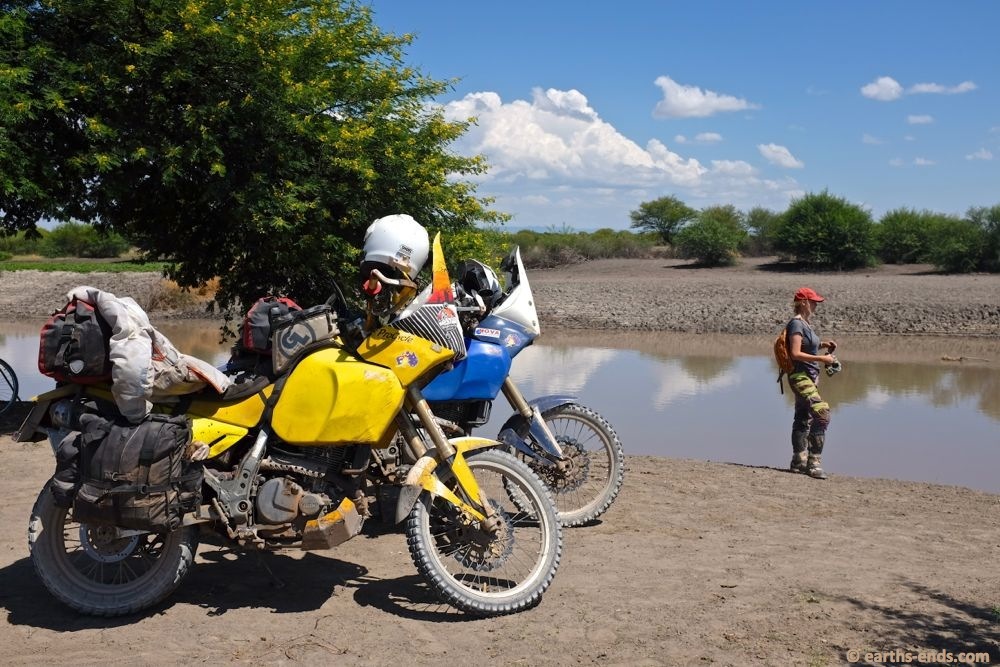
Contemplating our immediate future at the river. To cross, or not to cross? That is the question.
So the canoe was the only option across. That, or turn around and head south-west for the tar road. To be fair we were quite apprehensive to begin with. The canoes were dug-out palms with an open end dammed with a low mud wall to stop the water flooding in, and didn’t look too stable at all with their round bottoms and sitting so high in the water. And when William had done this route, he had done it on his little XR250. So we sat and waited with some snacks until two local piki-pikis came along, and watched how they went. It was a pretty slick and well practiced operation with two pikis in one canoe and their owners in another. Having seen that crossing, we thought it was doable.
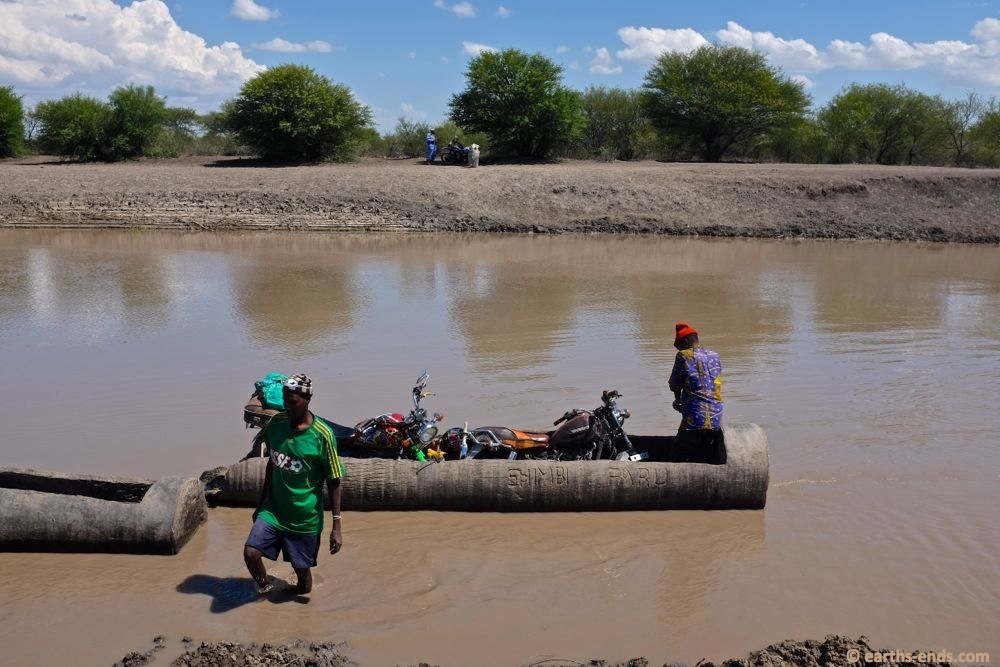
The two piki-pikis in the canoe. Looked doable… In fact it looked pretty good!
When the ferrymen returned to our side of the river, we used a bit of sign language to see if they thought they could get our bike across. They seemed positive, smiling and giving us the thumbs up while pointing at the dug-outs. Luckily, a masaai guy turned up who spoke quite good English and he helped us negotiate a rate across. William had advised he had paid 10,000 shillings for his bike and luggage, so when we got down to 12,500 shillings I figured that was fair enough considering our DR’s were a fair bit bigger and would require a lot more muscle. And they had started at a rate more that double that!
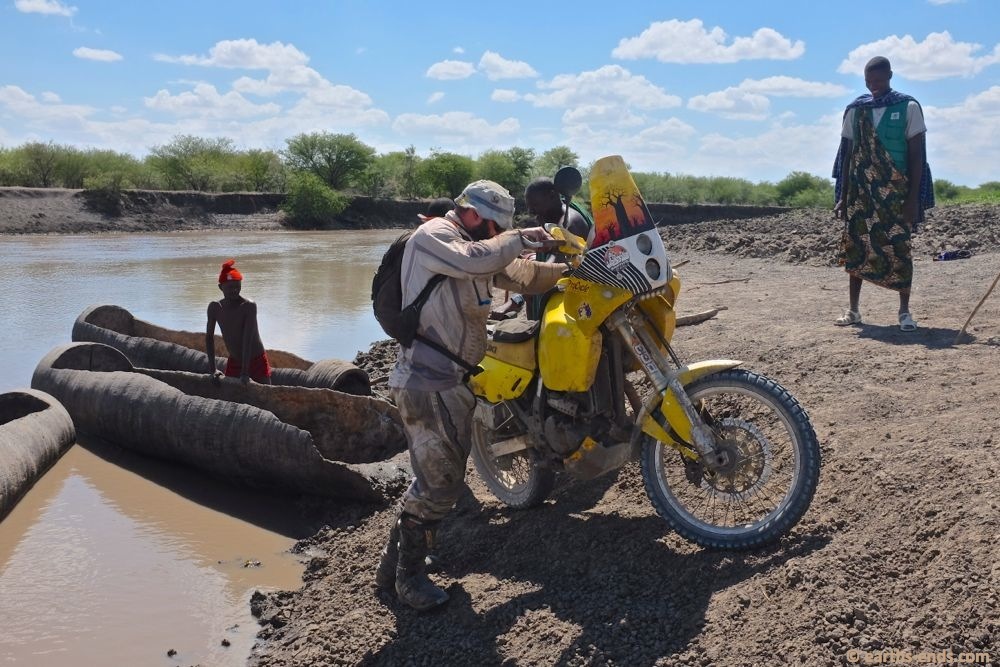
Backing Tan’s bike in. The bike moving dug-out had an open end with a dam made of pretty dry mud to stop the water flooding it. We backed the bike over the dam, then the ferry man patched it up with some fresh mud before we set off. Seemed legit, what could go wrong?

It was a massive group effort to get the bikes down the bank and into the dug-out canoe. The maassai fella who translated for us is on the right. He was a bit of a character, when we asked why he had crossed the river he replied “I have come to drink some LIQUER!!”
Tan’s bike went first. Its 1” lower than mine and the rear fuel tank was empty at the time, so it seemed like the better guinea pig. Plus it wasn’t mine. We backed the bike over the mud dam and into the canoe and loaded the luggage with me into another. When the ferryman pushed off and the canoe sat down in the river, we were relieved to see it looked pretty stable. It was leaning a bit with the bike but these guys knew what they were doing. This was going to work.
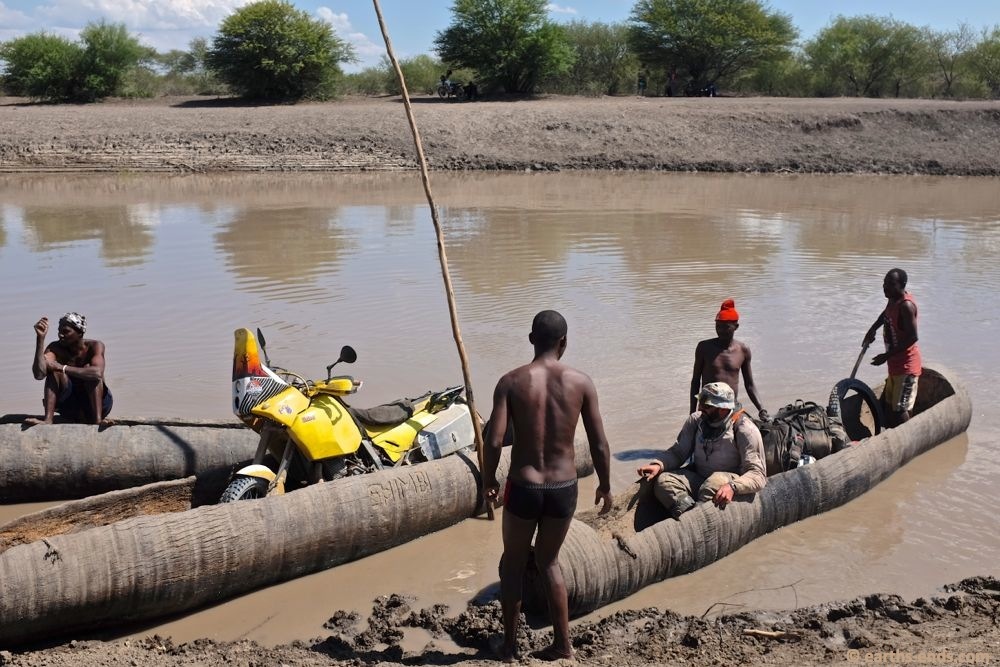
Tan’s bike about to set off, and me in the second canoe with luggage. Looking good so far.
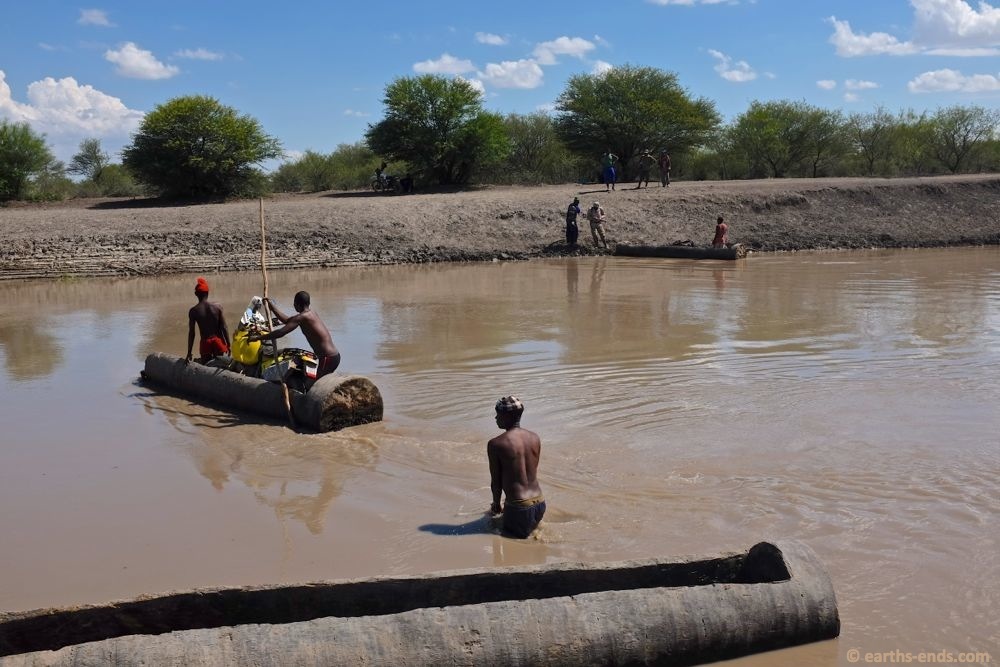
You can see the canoe with the bike had a bit of a lean on it, but it was stable enough.
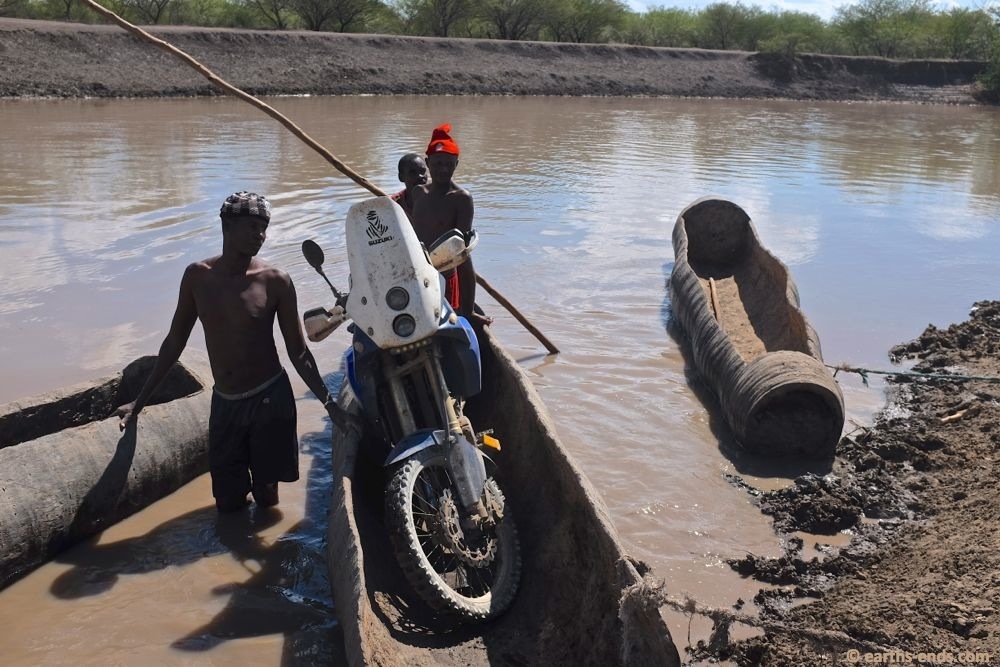
My bike in. The canoes were pretty narrow, I think you’d struggle to fit a beemer boxer twin in there.
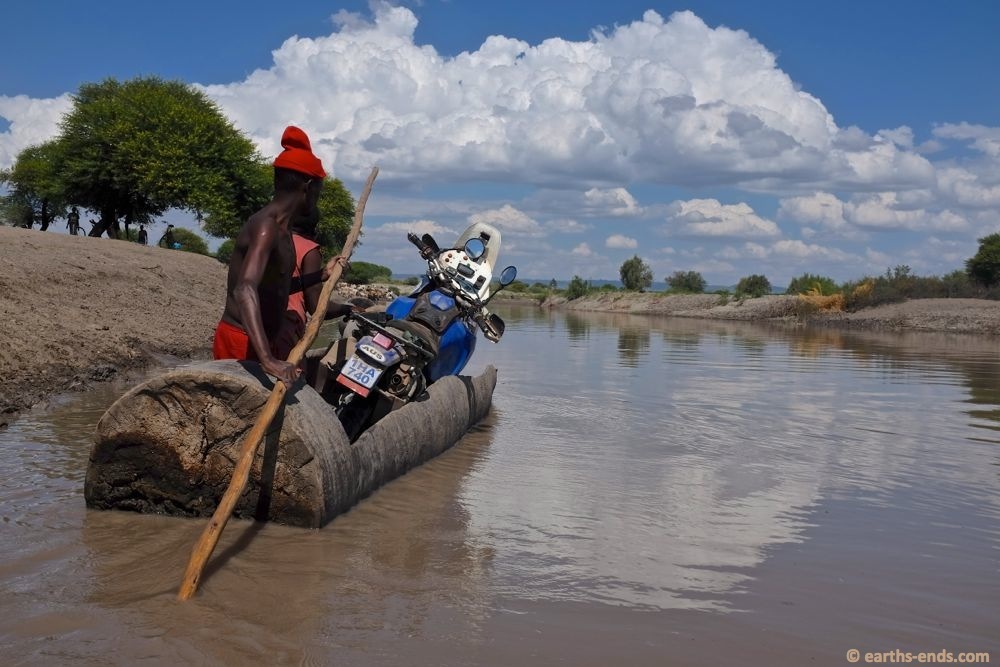
View from the dugout…
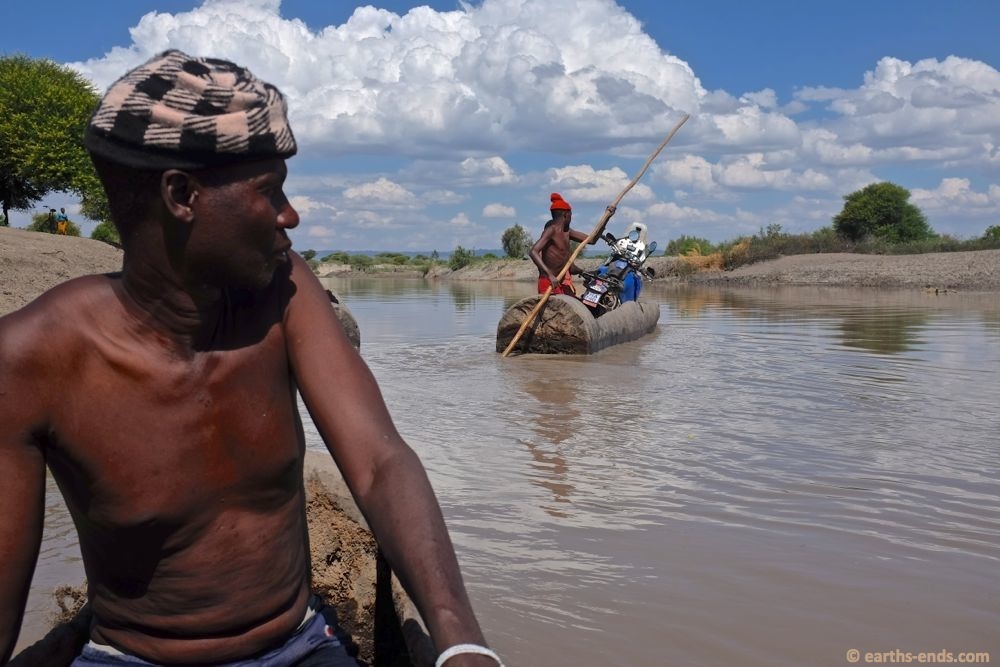
Piece of cake… sort of… ok…. This really was a bit heart in mouth…
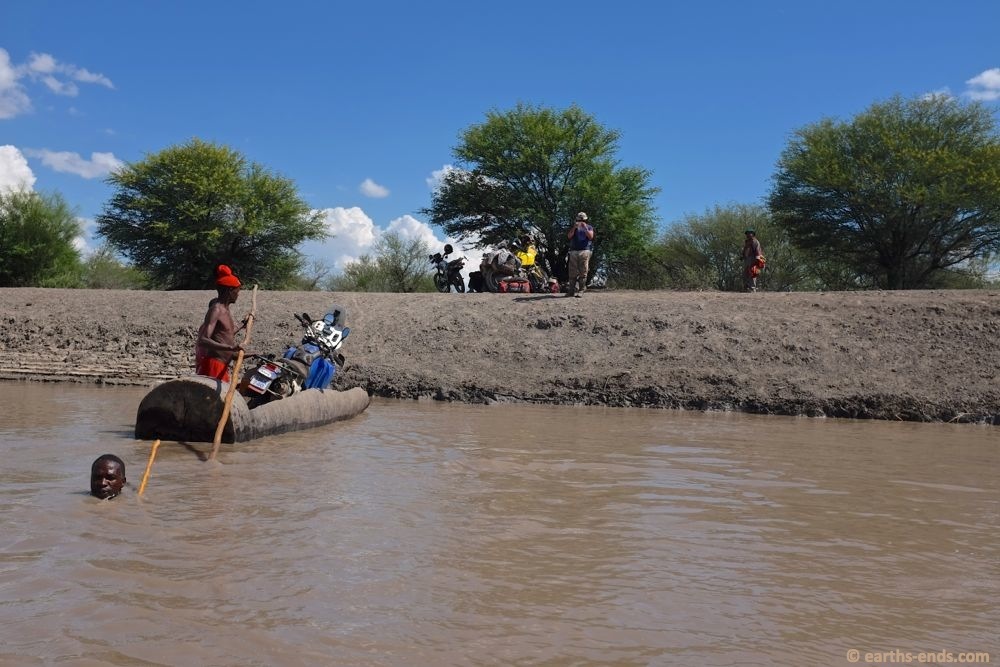
Did we mention it was deep?
Getting the bikes out at the other side was an effort. The canoe could only push onto the bank so far, meaning that the bike when it came out the end of the canoe sank into the last of the soft sticky mud. It was massive group effort to push it through. My bike came next with Tan supervising the guys as they loaded the bike and me looking on nervously from the opposite bank. Everything worked really very well in the end and the guys were stoked when we gave them a small tip (we paid once we got to the other side, just like the song says), I hadn’t planned on it and its not expected in a place like Tanzania, but everyone was sweating and huffing and puffing after unloading the bikes and luggage it seemed only fair.

Getting the bikes out was a mission.
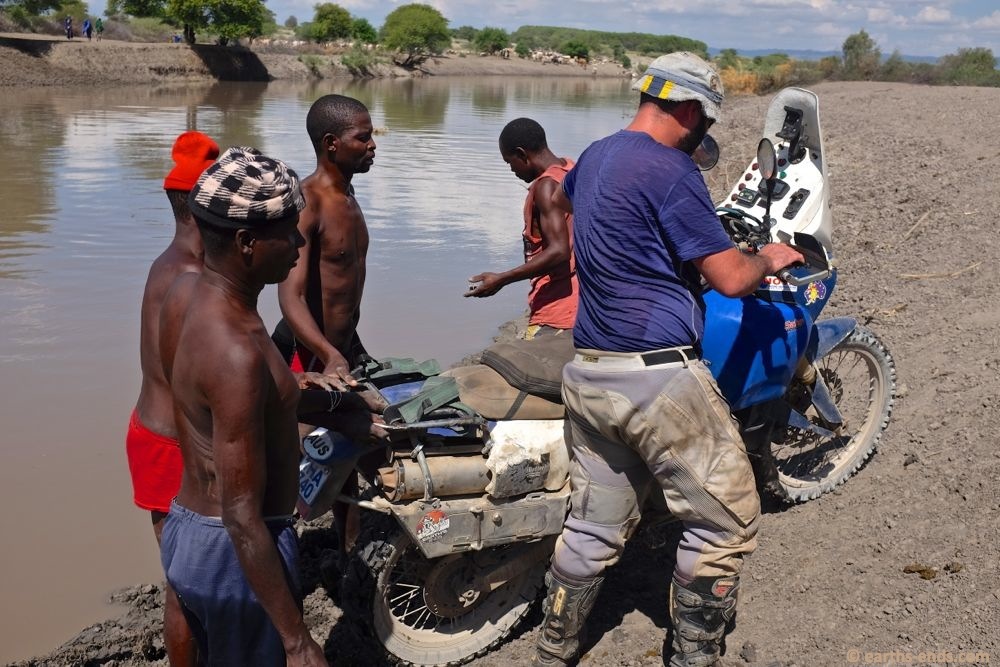
Between unloading all the luggage and then two bikes, I had a bit of a sweat on.
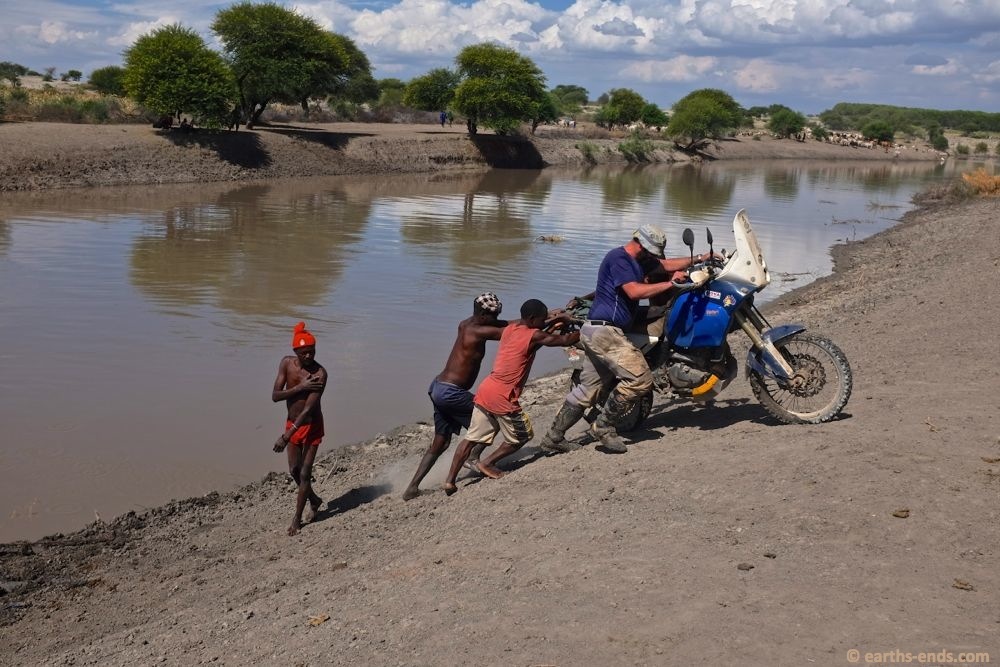
It was steeper than it looked! Promise!
After a rest in the shade we pushed on to the next village of Bukundi for a warm coke. From there the adventure subsided a whisker as we were back on proper dirt roads, however our pace picked up and we headed north-west. At the village of Laloga we found a clean little guest house for USD2 and with the sun about 30minutes from setting, it seemed like a good place to stop.

Obama is a popular bloke. At least out of the states anyway.
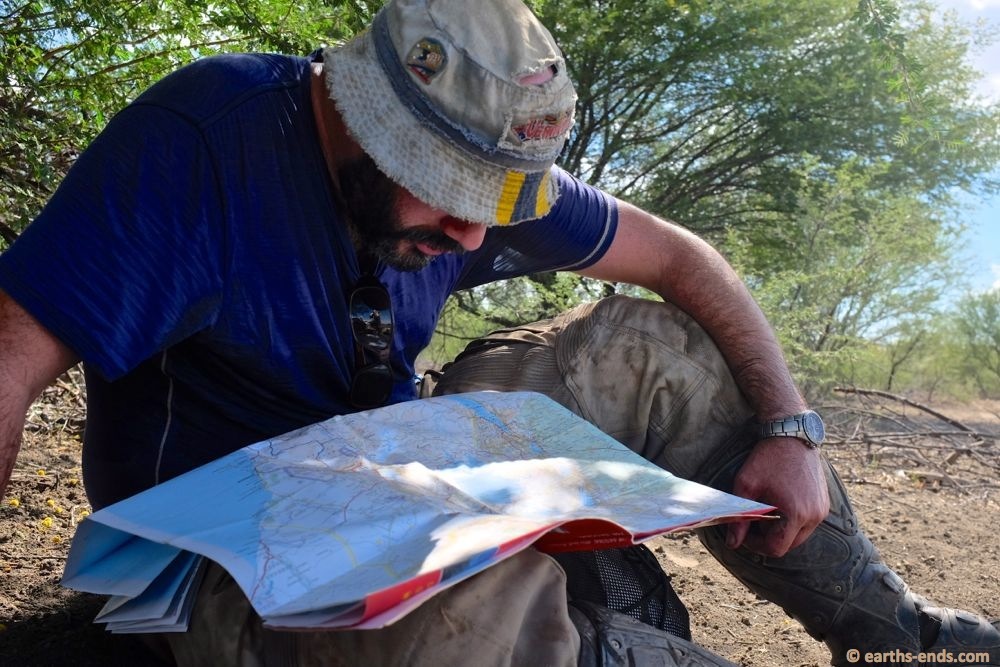
Ok, we are over the river. Now where?

After a bit of a rest and repacking the bikes we were ready to go.
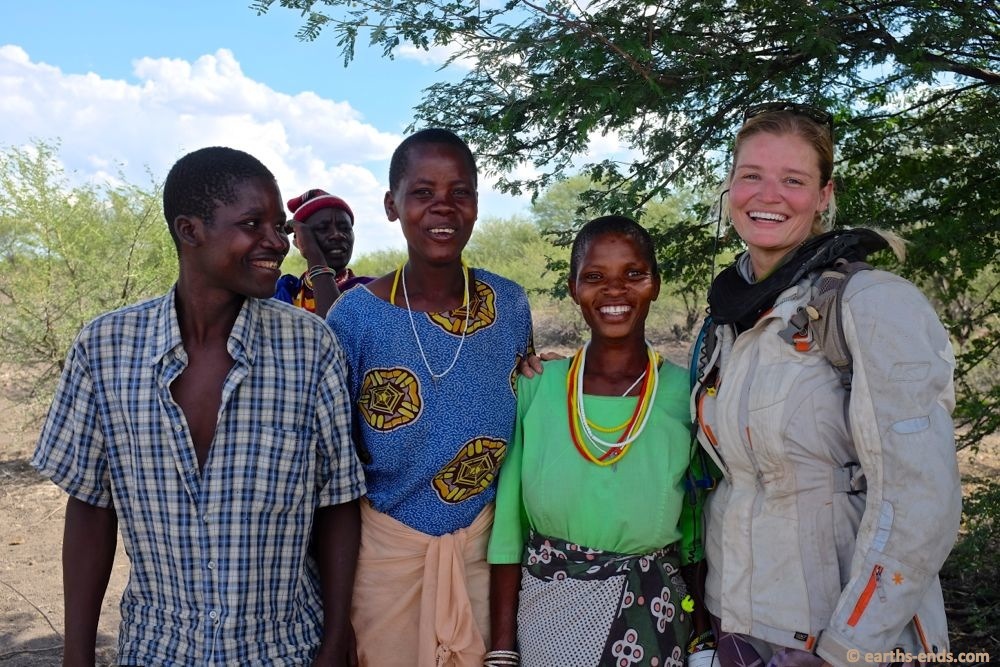
There were some friendly locals on curious to know what on earth two tourists were doing all the way out here in the middle of nowhere.
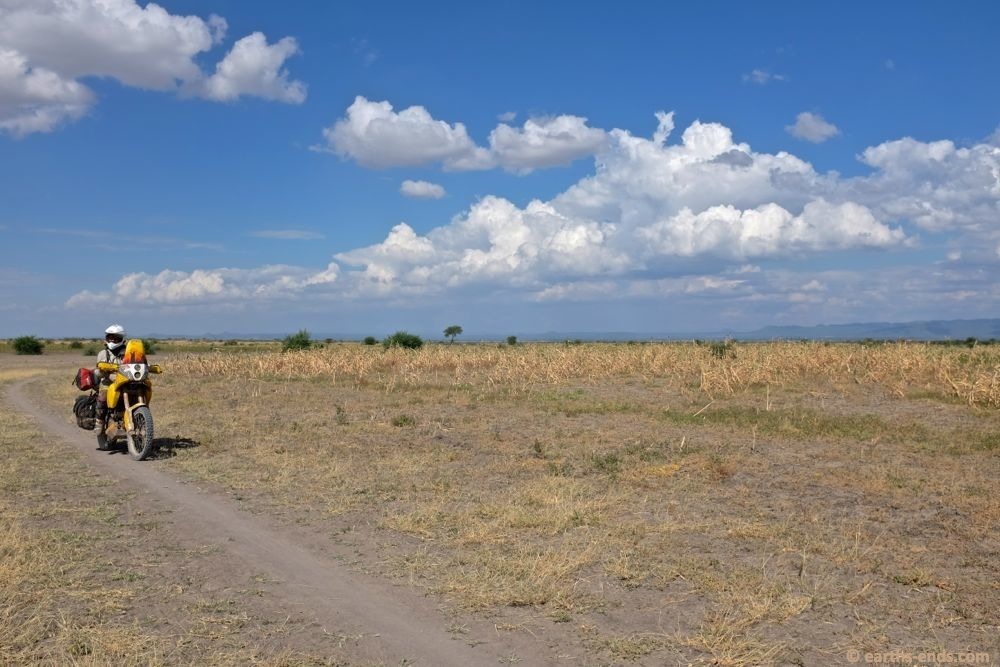
Piki-piki trails on the west side of the river. No cars here.
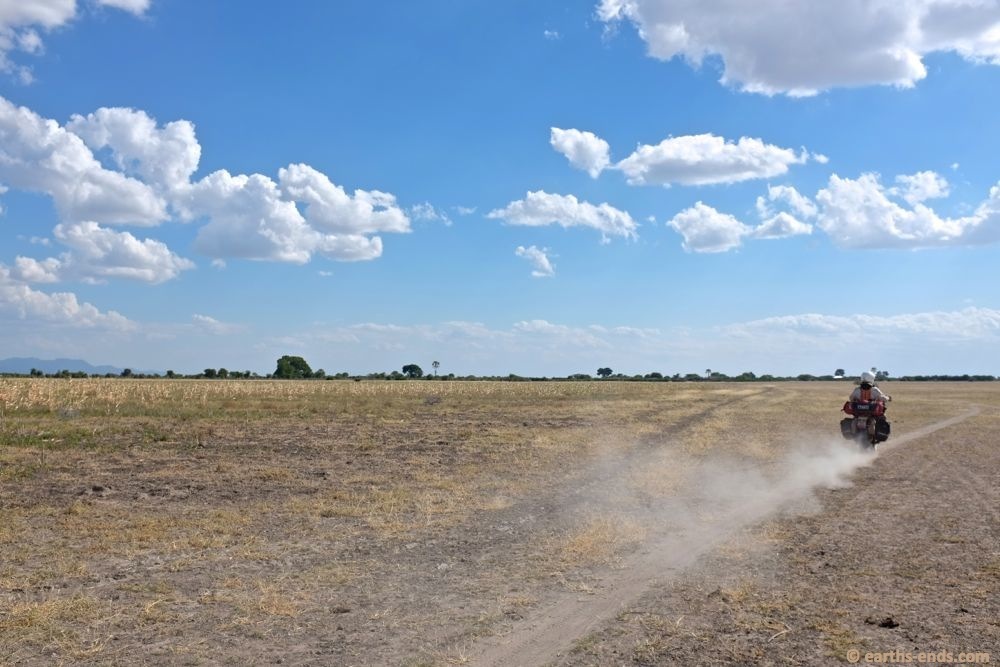
Go west!

We stopped for a cold drink in Bukundi, but failed. Only warm coke available.
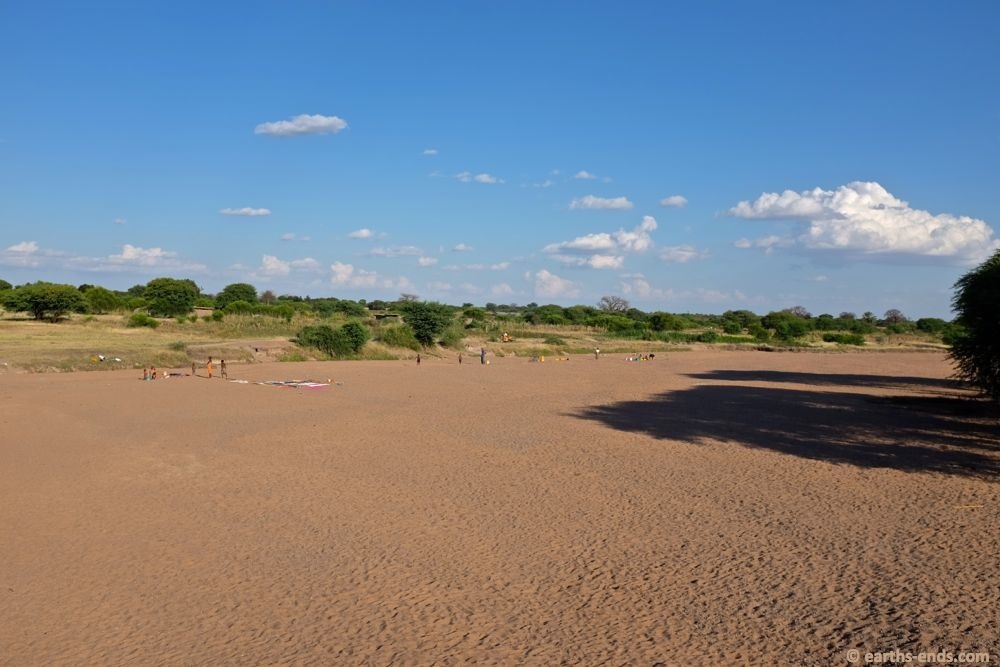
No running water out here, they are people decanting water from holes dug in the river bed. Every river we crossed had holes dug in the sand to extract water and people everywhere with water containers.
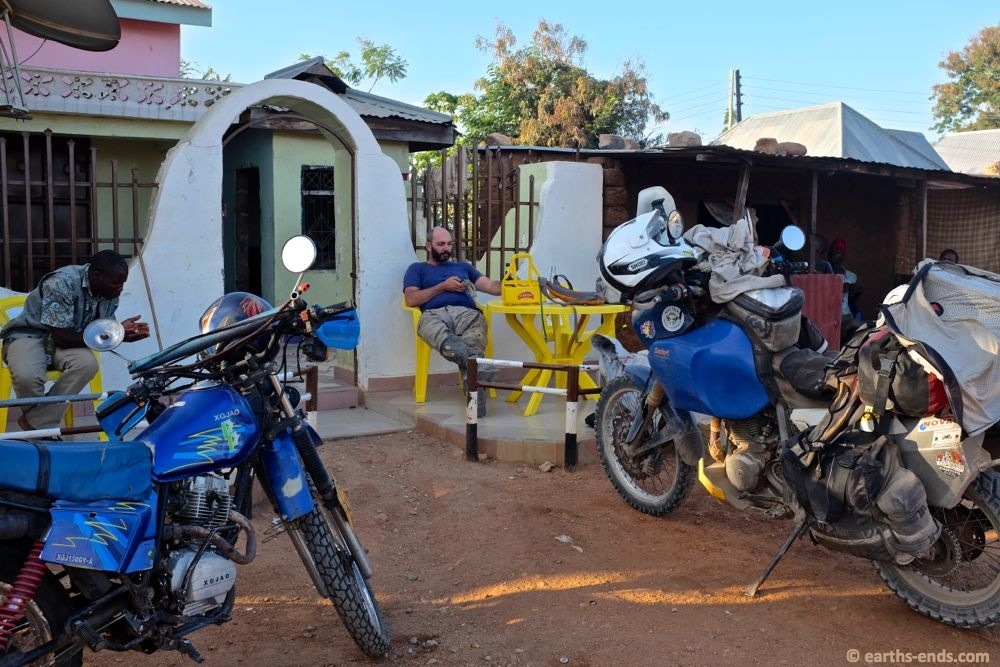
Our USD2 accommodation for the night. The beers were nice and cold which was very important after such an eventful day.
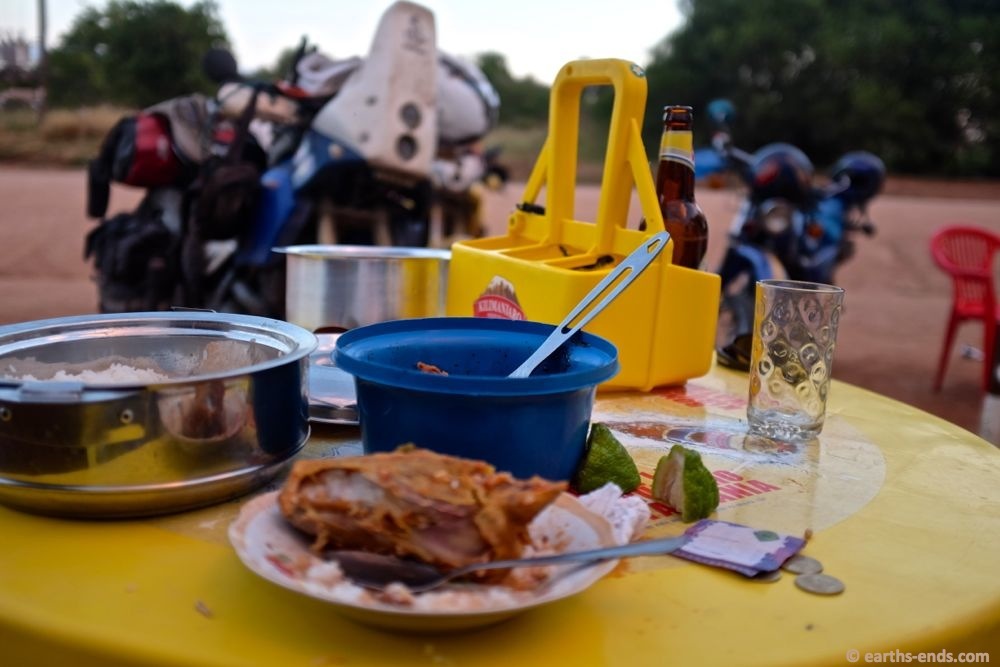
We got some dinner of chicken and rice and beans for TZS5000, about USD2.5 for both of us. The lodge owner was nice and got a good rate for us. A local guy wanted to sell us a whole chicken for 10000, and with rice for 15000. When we baulked at the cost the owner sorted us out a good dinner for cheaper.

These kids hadn’t seen many tourists. They were curious….
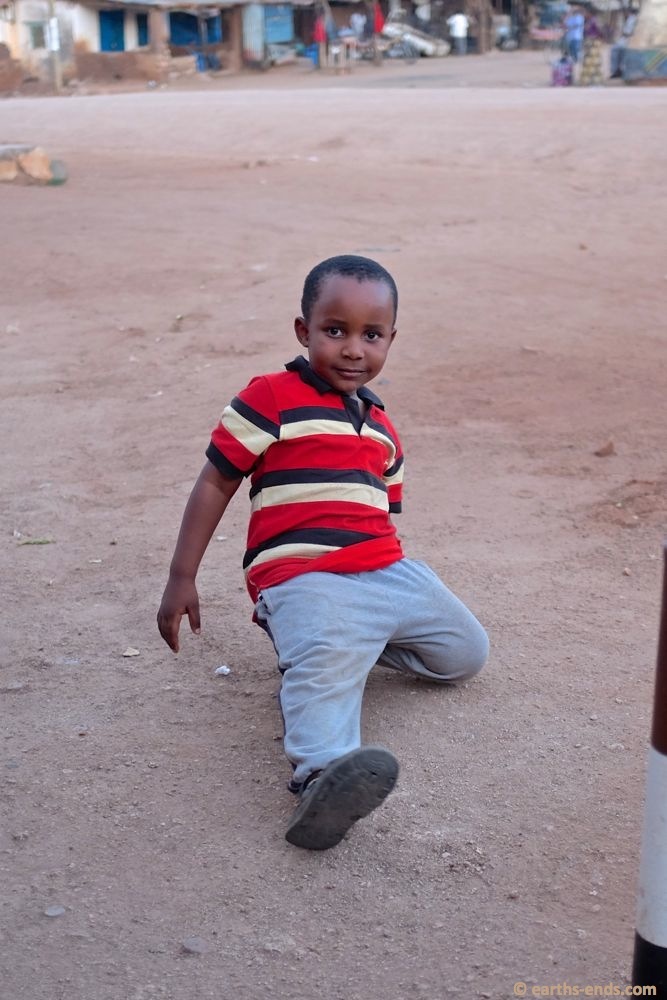
…. And keen to show off for the camersa.
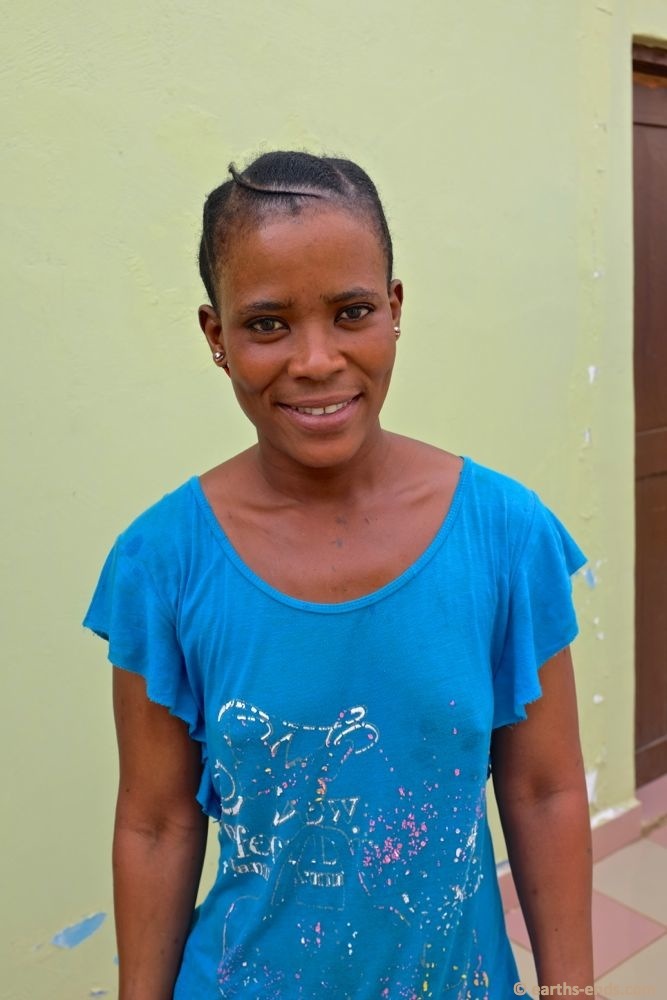
One of the ladies who worked in the hotel was keen for a photo, she asked us to take on of her.
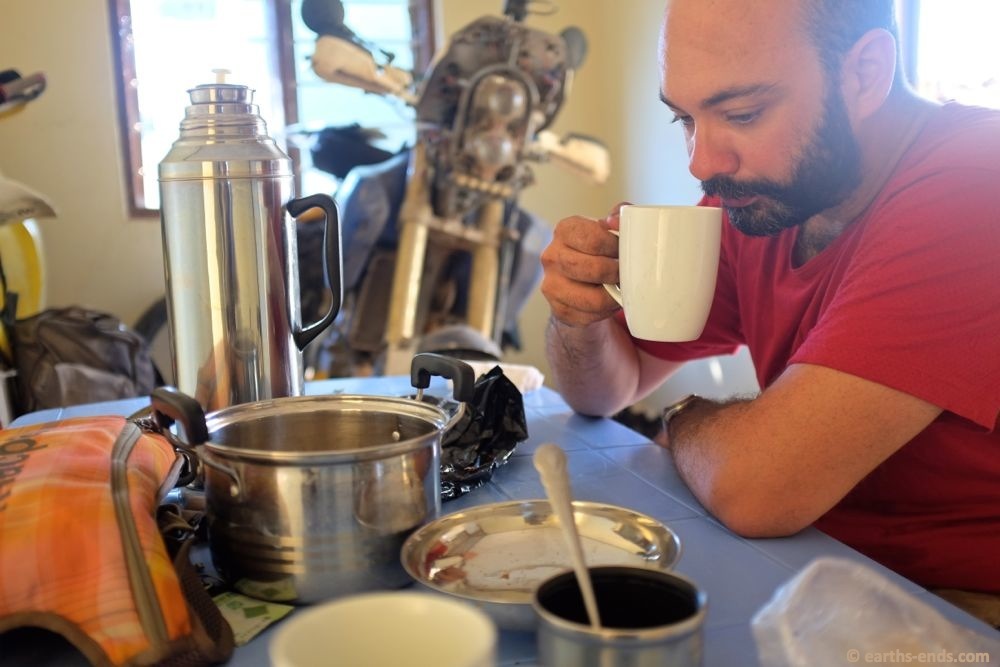
Breakfast in Tanzania is always tea and chipatis. Nice sweet milk tea, generally spiced, and fresh chipatis. Awesome.

We had to sortout some issues before hitting the road. The mud from riding around kili or maybe from the crossing made my fork seals leak so quickly cleaned them. I also had a few electrical issues; a fuse was out meaning I had now power to the front of the bike and I also found a broken wire which meant the high beams weren’t working.
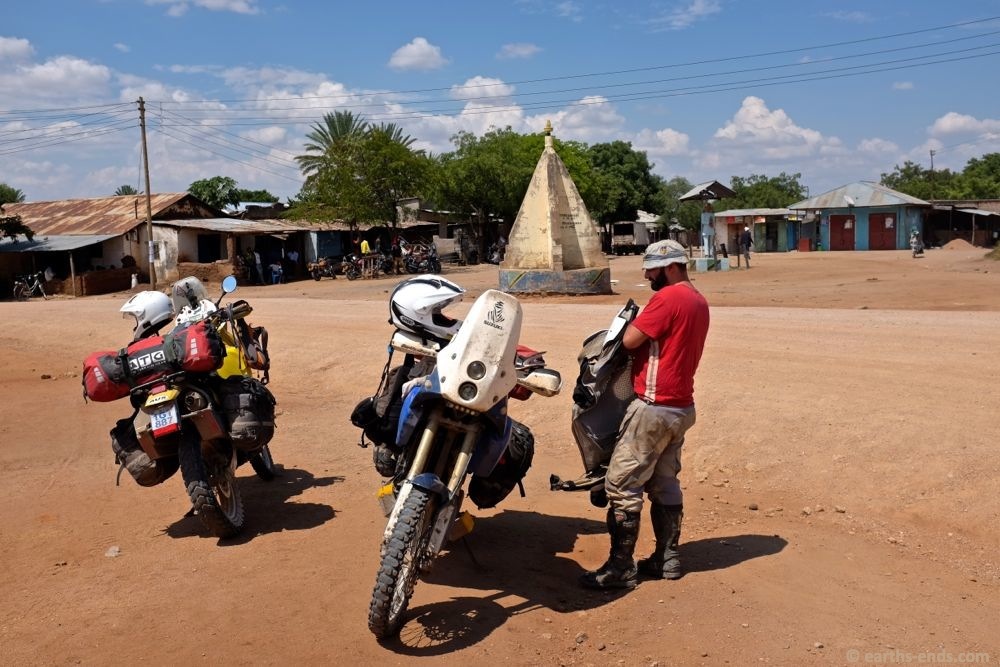
Hit the road Jack!
From there we had about 70km of dirt road, then we were on the tar that we would have to share with the trucks and buses all the way to Rwanda. We made about 400km that day and ended up in a tiny little town about 100km from the border. It was our last full day in Tanzania – for now anyway. We did our usual trick of getting some chipatis and tea in the market for dinner and breakfast the next morning and made the last dash for Rwanda.
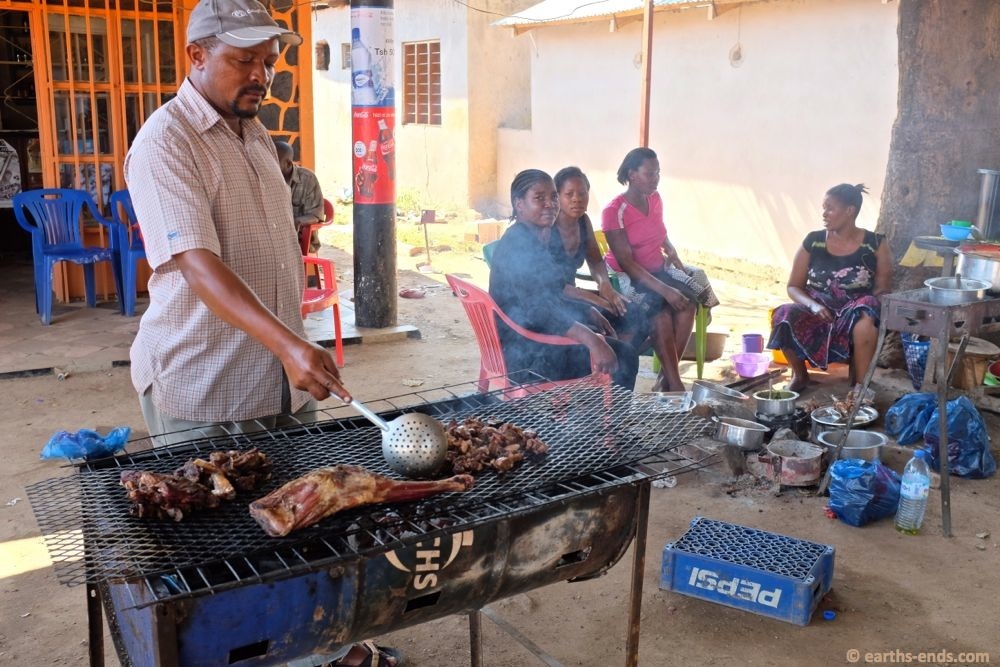
Lunch stop on the way to the border…

Our cheap accommodation for the night. No running water and the toilet is just a hole in the ground, but it was only USD2 and had a mosquito net. And no bed bugs… Places like this are so tight for cash that when we arrived, the lady who ran it sent a text message to the water delivery guy who then turned up on a bicycle to deliver water so we could wash.
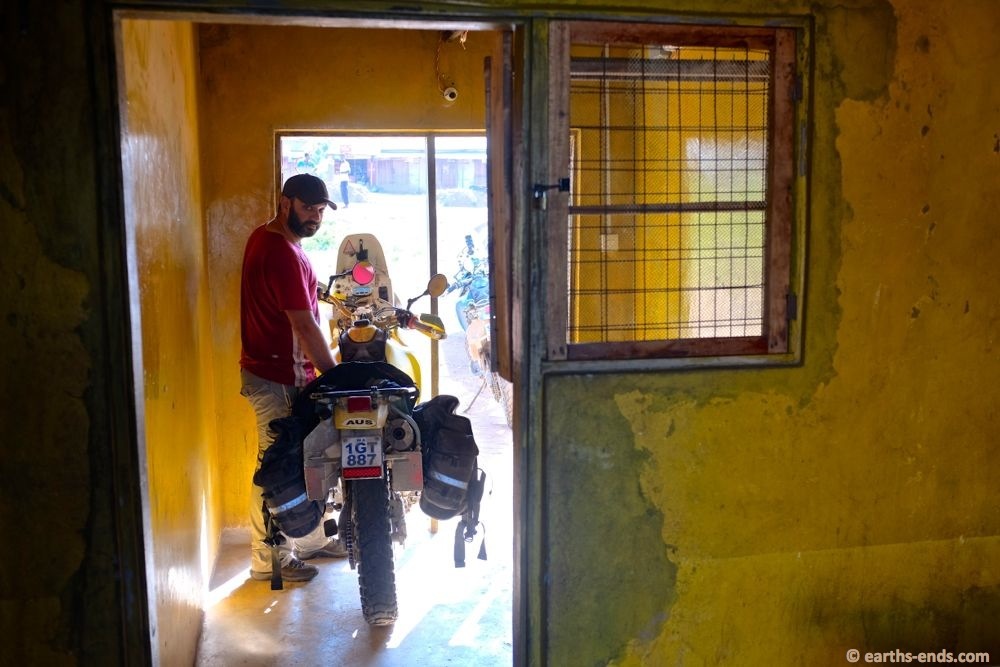
Getting our bikes out in the morning.
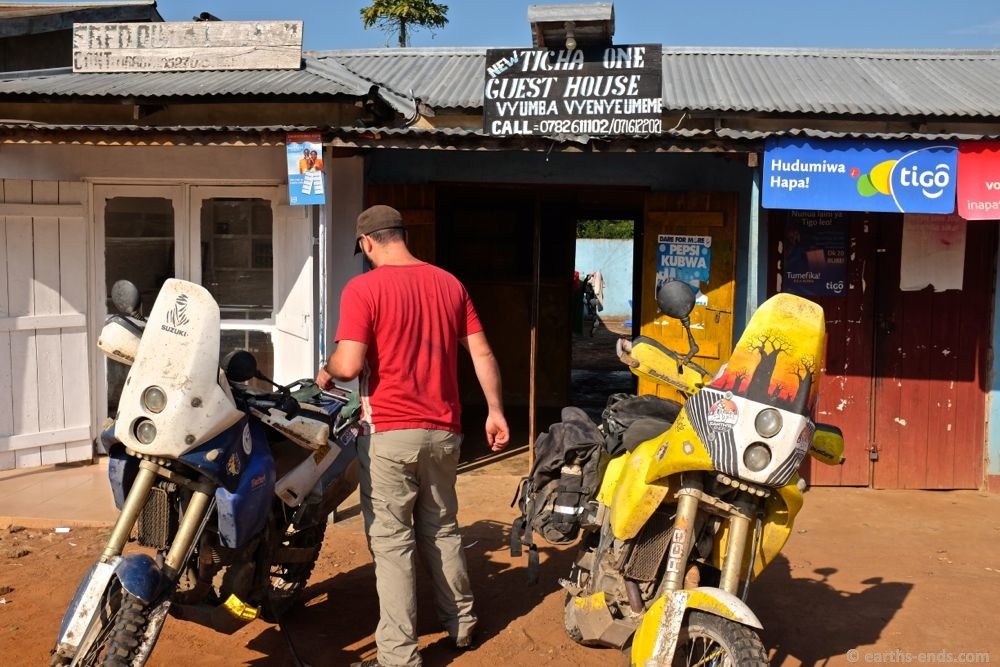
Our tiny little guesthouse. Seems no matter how tiny, every town in Tanzania has a tiny guesthouse of some description. Most are pretty basic, like this one.
 Earths-Ends
Earths-Ends
Just love this! I so miss riding in Africa. It’s the real deal travel. Keep it coming!